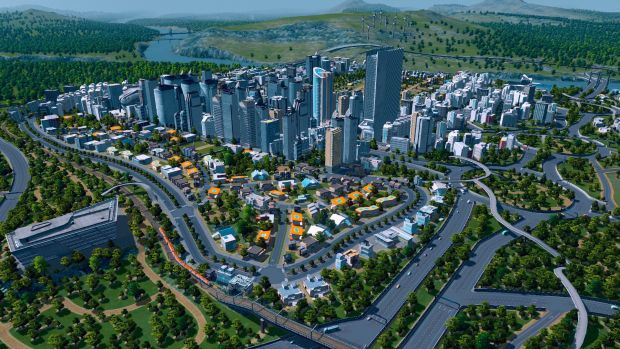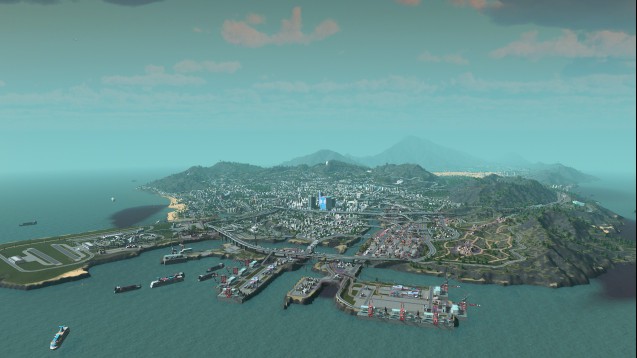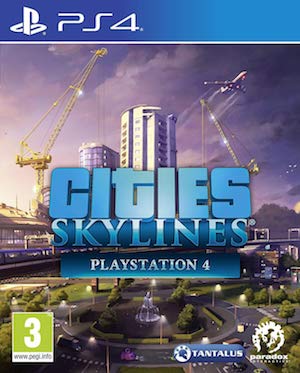
When you think about a game that can topple the mighty SimCity franchise, Cities: Skylines may not quite be what comes to mind. While SimCity as a series hit rock bottom with the last release – which went online and focused on multi-city set-ups, cooperating with friends and other useless endeavours – Cities: Skylines takes a traditional approach. “Traditional” may be the wrong word – minimalistic best describes the various feature-set in Cities: Skylines and it’s an excellent example of less being more.
Starting the game out is an exercise of sorts. There’s no abject tutorial to tell you what to do or how to go about building your city and the little Twitter knock-off at the top of the screen, which often inundates you with feedback on the state of your city, isn’t going to be your source of helpful information when you first start out.
"Those worried about scale with the initial 4 square kilometers land need not worry for long because Cities: Skylines eventually branches out to 36 square kilometers. In a way, it harkens back to the old days of SimCity where your city quietly but quickly expanded and you can survey the denizens as they go about their lives."
Nonetheless, as in SimCity, you’ll be putting roads down, managing traffic, building factories, defining districts and essentially giving your citizens what they need. A rather nice feature are zones that begin to show up right next to roads you’ve put down, allowing you to quickly and efficiently set them up. Cities: Skylines then allows to regulate each district separately, letting you to decide if those fancy high-rise buildings will subsist with the quaint suburban towns (at a price of course).
One can create tax incentives; introduce recreational drugs to effectively reduce crime in troubled zones or just outright set-up industrial wastelands in charge of stripping the land of its resources. There’s a lot of freedom to the kind of city you want to create and Cities: Skylines thankfully bestows a personal touch to the various districts, letting you name them and meticulously craft them to exist in the metropolitan ecosystem.
Those worried about scale with the initial 4 square kilometers land need not worry for long because Cities: Skylines eventually branches out to 36 square kilometers. In a way, it harkens back to the old days of SimCity where your city quietly but quickly expanded and you can survey the denizens as they go about their lives. While Cities: Skylines isn’t pushing today’s graphical hardware to the limit, it does a fantastic job of capturing all the minute details that make up a city.
It almost feels like each character has their own life with workers scurrying off, teachers attending school and whatnot. For all the hype about graphics in video games, Cities: Skylines makes a strong case for focusing on the basics and excelling at them in every turn. So while it may not be the graphically advanced game I’ve ever seen, the sights and sounds it presents are undoubtedly beautiful.
"This is welcoming for new players of the genre but veterans who don't consciously try to destroy their city may find the sailing to be a tad too smooth. And even the veterans will have a hard time making sense of the transit system in Cities: Skylines."
Whether it was by design choice or budgetary constraints (most likely the former than the latter), Colossal Order hasn’t included any random disasters or sudden shifts that could topple your city. It also does a very good job of making sure you don’t actively ruin your city, allowing you to make modifications to districts as the city expands without having to tear things down and start from fresh.
This is welcoming for new players of the genre but veterans who don’t consciously try to destroy their city may find the sailing to be a tad too smooth. And even the veterans will have a hard time making sense of the transit system in Cities: Skylines. There’s also the lack of any real goals, even reactionary ones such as preparing for the worst when a disaster does arrive.
On the one hand, this presents a focus on building and achieving the maximum level of efficiency. On the other hand, some random excitement isn’t necessarily a bad thing. It only serves to highlight Cities: Skylines’ tendencies to innovate within the box rather than outside it. To that end, you won’t see crime spiralling out of control and even as your citizens voice their complaints in the little tweets box, you won’t find the approval rating dipping very far down.
End-game content may seem like an issue but thanks to the in-depth mod editor – which community members are already using to create some awesome additions like a Flight Simulator mod – you’ll find plenty of things to play around with in the coming months.
Cities: Skylines is a game that focuses on construction more than destruction, presenting a game that subtly improves on every aspect of SimCity while still maintaining its own identity. It may not beat EA in terms of graphical power or scale – though the publisher arguably beat it with those goals when SimCity (2013) went down the tubes – but it does present the very essence of city-building distilled down into an appealing, enjoyable, largely approachable and fun mix. And really, that’s all we ever wanted.
This game was reviewed on the PC.
Awesome city building mechanics and customization. Ability to distinguish districts in an organic way. Detailed cities and large scale for building. Mod editor leading to great new additions already.
Lack of tutorial makes for somewhat imposing learning curve. Transit system is a curious puzzle. Not the prettiest city builder around. Lack of any real "gimmicks" like random disasters.



















